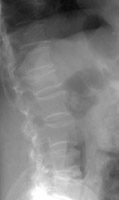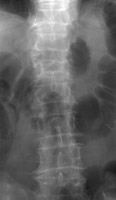 A
A B
B C
C D
DCompression Fracture (Lumbar) |
Compression fractures of the spine are common in elderly and osteoporotic patients. They result from anterior or lateral flexion. The typical appearance is loss of height of the anterior aspect of the vertebral body with preservation of the posterior elements and generally the posterior aspect of the vertebral body. On the frontal view, there may be subtle deviation of the paraspinous line due to edema. Differentiation from a pathologic fracture of the spine due to a metastasis is usually of clinical concern, but simple compression fractures are usually due to osteoporosis.